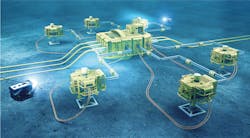Subsea Valve Actuator Capitalizes on Strengths of Two Drives
A growing trend in the offshore industry is to move all the equipment needed for offshore exploration and production of oil and gas down to the seabed. Known as the All Seabed Factory, this technology facilitates increased automation, safety, and efficiency, along with considerable cost reduction and reduced environmental impact.
Until now, valve actuators used in these subsea applications have been primarily either electromechanical or hydraulic, each with its own set of benefits and shortcomings. Electromechanical systems avoid the complexities of conventional topside hydraulic systems but require more space. Hydraulic actuators are more compact because they have greater power density, but they also require a large HPU with related topside infrastructure and footprint, as well as long hydraulic supply lines and couplers that can leak and compromise the environment.
A New Approach
Combining the best of both technologies, Bosch Rexroth recently introduced its Subsea Valve Actuator (SVA), an electromechanical actuator with a hydrostatic drive. It achieves the same safety performance as a hydraulic actuator but with greater reliability. It also provides a simple electric interface similar to those in all-electric actuators and eliminates the umbilicals otherwise needed with hydraulics.
The SVA is a cost-effective modular design, suitable for operation at depths up to 3,000 m and with any kind of subsea valves. All components are immersed in hydraulic fluid with a pressure-compensation system. The drive and safety systems are completely redundant, and electric components are protected against seawater ingress. Redundancy extends to an analog subsea electrical interface that follows the Subsea Instrumentation Interface Standardization (SIIS) and the pressure compensation system. Sensors are integrated for monitoring redundant absolute actuator position, working pressure, temperature, pressure-compensation volume, and water ingress.
In operation, the SVA is controlled by an Actuator Control Module (ACM), which provides the motion control algorithm, the safety signal, and the condition-monitoring features for each actuator. A second ACM monitors functioning of the system and takes control of the actuator if the first ACM fails. Independent electric subsea cables connect the actuator to each ACM, so that if a single electric control fails, the other will assume control automatically. Optional features include a mechanical override with a position indicator and a port for refilling the hydraulic fluid. In addition, a seawater filter protects the pressure compensation mechanism from particle contamination, and a bursting disc protects against system overpressure during decommissioning.
The drive system uses an electric motor submerged in hydraulic oil to drive a dual-pump system. Having two pump ensures system reliability. Each system can provide the needed force individually, or both pumps can be used together to reduce load. Two separate chambers of the cylinder move the actuator in or out. A third chamber is used to clamp a failsafe spring hydraulically to reduce power consumption during actuation of the subsea valve without compromising the emergency closure safety function.
The SVA is designed to perform for 25 years with high system uptime and minimal maintenance. Much of this is due to its design redundancy and the use of proven industrial components. Redundant systems and seals that incorporate additional safety factors reduce the possibility of seawater contamination to protect the standard components. This provides cost savings without sacrificing reliability. For example, the industrial valves used in the system are qualified for more than 10 million cycles.
Best of Both Worlds
Electromechanical actuators with hydrostatic drives are more energy-efficient than either type alone. Their compact design provides greater power density, lower static friction forces, and greater ability to match system control to varied speed and load conditions.
Compared to a typical hydraulic system, the combination drive reduces capital investment and space requirements by eliminating the topside hydraulic power unit. It also cuts operating costs by eliminating the need for periodic refills of hydraulic fluid. Because it can be operated with a simple DC or fiberoptic system, umbilicals with hydraulic power lines are not needed, eliminating a potential source of fluid leakage. With piping work done mainly at the subsea trees and manifolds, material and commissioning costs also are reduced significantly in comparison with a topside system.
Compared to a typical all-electric actuator, the manufacturer states that up to a 75% reduction of the peak electric power for each actuator is possible with the combined system. When applied across the subsea production field, this reduces overall demand for electrical power considerably, which, in turn, lowers both operating expenses and the capital investment required for subsea electrical power distribution equipment. In addition, the new system provides greater uptime availability and efficiency due to its high safety level, reliability, and condition monitoring.
Information for this article was submitted by Dr. Alexandre Orth, Senior Manager of Sales, Marine and Subsea Technologies, Bosch Rexroth GmbH. For more information, call (800)-739-7684, or visit www.boschrexroth.com/en/us.


